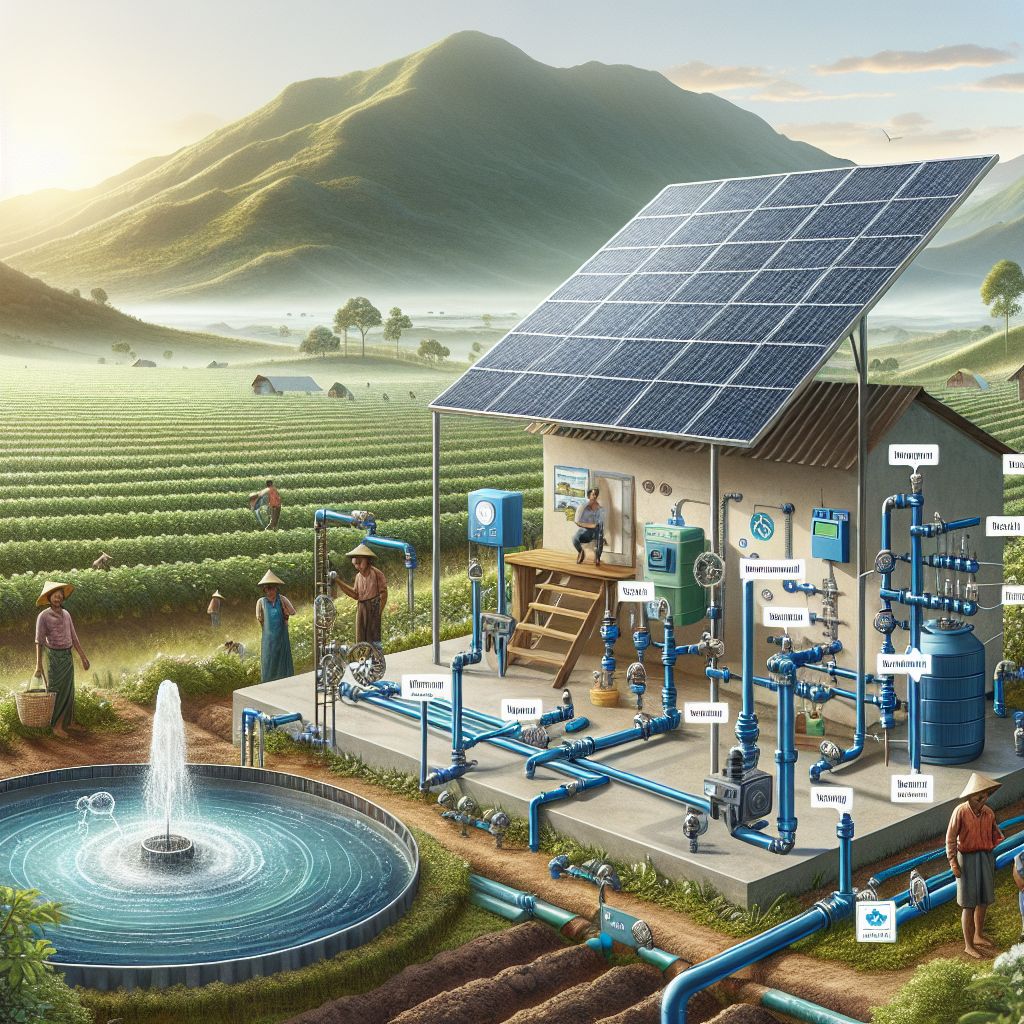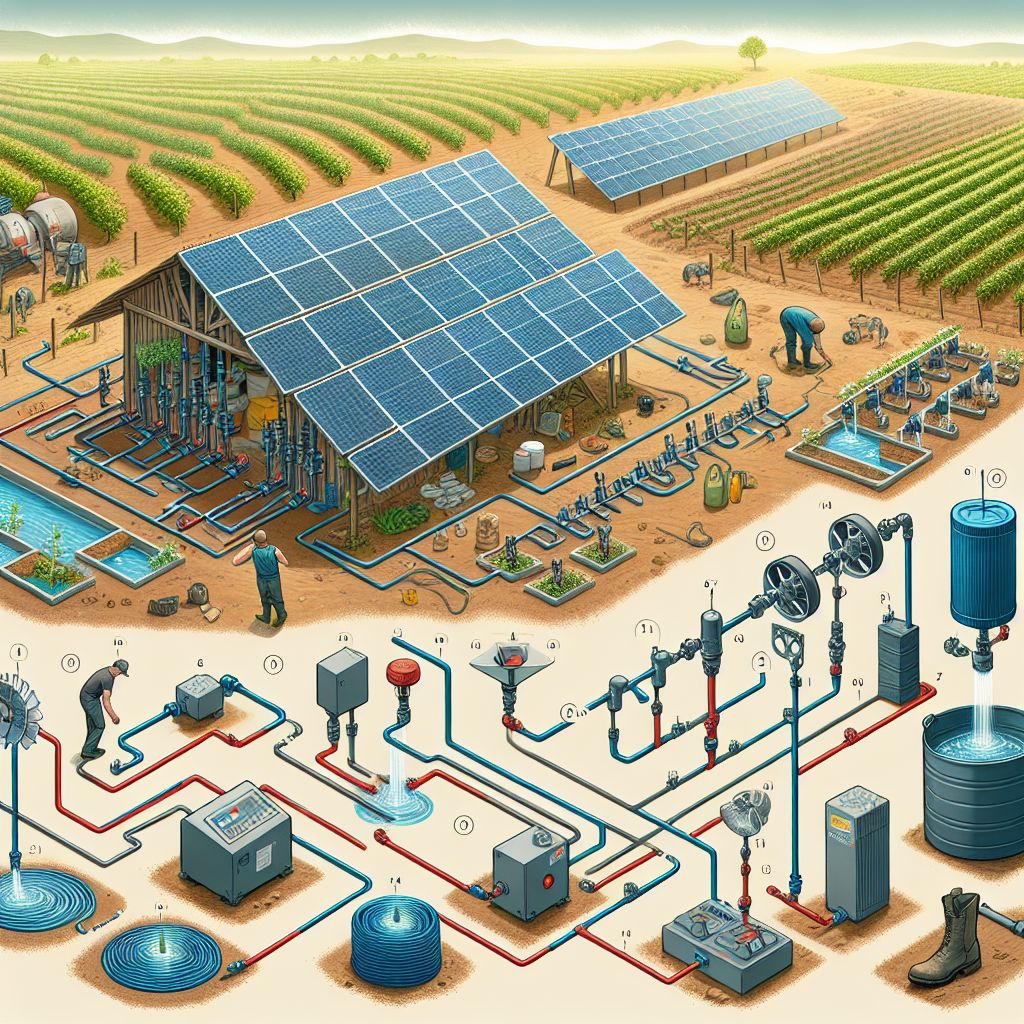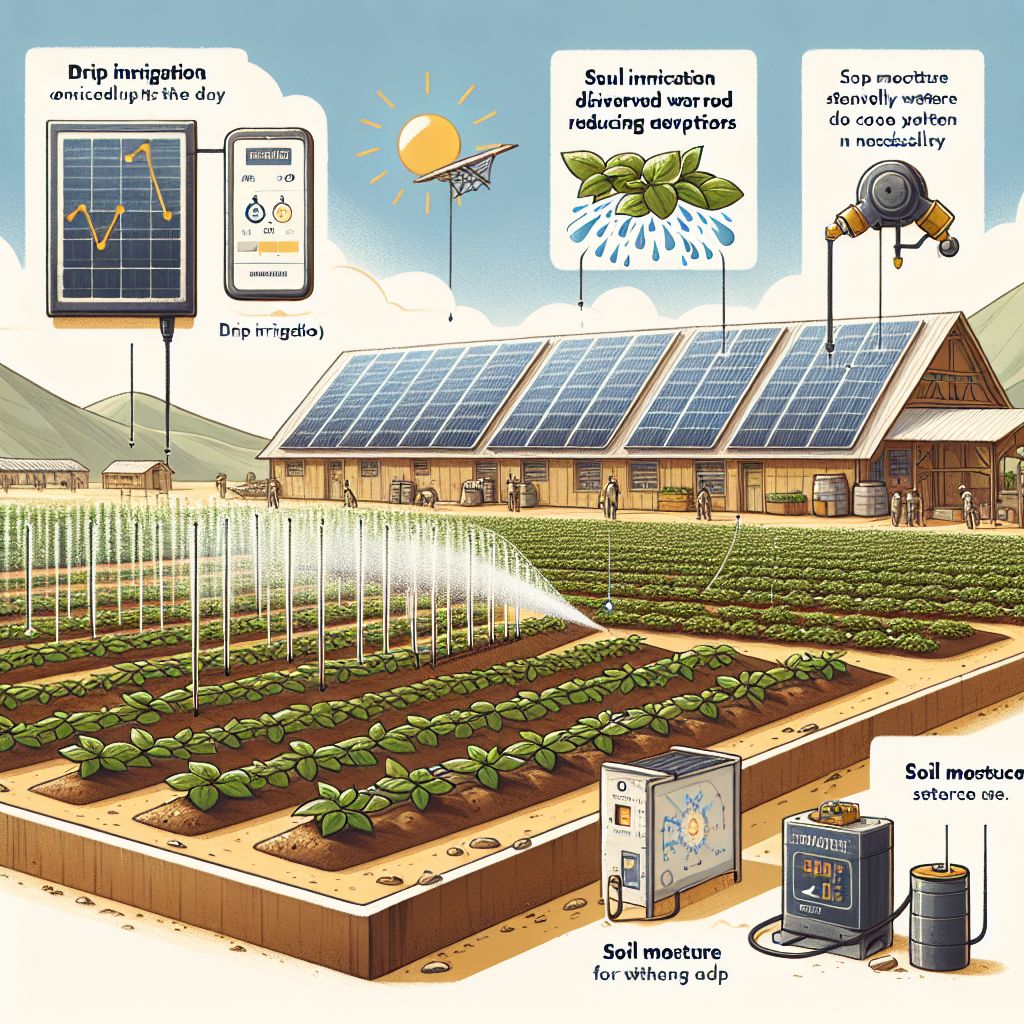
Key Takeaways
-
Solar-powered irrigation is a game-changer for remote farming, providing water without relying on grid electricity.
-
Understanding the components and setup of a solar irrigation system is crucial for efficiency and sustainability.
-
Assessing water needs and choosing the right solar pump are vital first steps in going off-grid.
-
Proper water management and system maintenance are key to the long-term success of solar-powered irrigation.
-
Real-world examples show that solar irrigation is not just feasible but also profitable for farmers in diverse climates.
Harvesting the Sun: Solar-Powered Solutions for Remote Farms
Sometimes, the simplest solutions can trigger a revolution. For farmers in remote areas, one such solution is harnessing the sun’s power to irrigate crops. It’s a clean, sustainable, and increasingly accessible technology that’s changing the face of agriculture as we know it. Let’s dive into the world of solar-powered off-grid farming and explore how it’s not just a possibility, but a practical reality for today’s eco-conscious farmer.
The Problems of Farming on an Off-Grid Farm
Off-grid farming presents a unique set of challenges. Without access to the main electricity grid, tasks that others take for granted, like pumping water for irrigation, can become logistical nightmares. Diesel generators are noisy, polluting, and costly. Most importantly, they’re reliant on fuel that’s subject to price fluctuations and availability issues. That’s where solar power steps in – it’s reliable, clean, and after the initial setup costs, virtually free.
Here is a table outlining some of the key problems and challenges faced by farmers operating an off-grid farm.
| Problem | Explanation |
| Lack of Refrigeration | Without access to grid electricity, off-grid farmers have limited options for refrigeration to preserve perishable crops and animal products. This requires careful timing of harvests and deliveries. 2 |
| Reliance on Manual Labor | Off-grid farms often lack access to labor-saving appliances and machinery that rely on electricity. This means more manual work for tasks like milking, food processing, and heating. 2 |
| Difficulty Storing Energy | Solar and other renewable energy sources can provide power, but storing enough energy in batteries to power an entire farm operation can be challenging and expensive. 2 |
| Vulnerability to Weather | Cloudy, rainy, or snowy weather can severely limit the ability to generate solar power, leading to power shortages and the need to ration energy use. 2 |
| Isolation and Loneliness | Living and working completely off-grid can lead to feelings of isolation, with fewer opportunities to interact with people outside the immediate family or community. 3 |
| Maintenance and Repairs | Without easy access to parts and repair services, off-grid farmers must develop strong DIY skills to fix equipment, machinery, and infrastructure when it breaks down. 3 |
| Earning Income | Selling products at farmers markets or to local customers is important, but off-grid farmers may have fewer options to diversify income streams. 3 |
| Health and Medical Care | Access to healthcare and emergency medical services can be more limited in remote, off-grid locations, requiring self-reliance and preparation. 3 |
The key for successful off-grid farming is careful planning, self-reliance, and an ability to adapt to the unique challenges of operating outside of the traditional grid infrastructure.
The Basics of Solar-Powered Irrigation So You Can Farm Off-Grid
To get started with solar-powered irrigation, you’ll need a few basic components: solar panels to capture the sun’s energy, a pump to move the water, batteries to store that energy, and a controller to manage the system. The beauty of this setup is its simplicity and the independence it offers. You’re no longer tied to fuel deliveries or power lines; your farm’s water supply is as reliable as the sunrise.
Right below is a table that shows some keyways how a solar irrigation system can help overcome the challenges of farming off-grid.
| Challenge | How Solar Irrigation Can Help |
| Lack of Access to Reliable Electricity Grid | – Solar-powered irrigation systems can provide a reliable and affordable energy source for irrigation in areas with limited or no access to the electricity grid. 1, 2, 3 |
| High Operational Costs of Diesel Pumps | – Solar irrigation systems have lower operational and maintenance costs compared to diesel-powered pumps, reducing the ongoing expenses for farmers. 1, 2, 3 |
| Greenhouse Gas Emissions from Diesel Pumps | – Solar irrigation systems do not produce any greenhouse gas emissions during operation, making them a more environmentally-friendly option. 1 |
| Groundwater Overexploitation | – While solar irrigation can enable increased water usage, proper management and regulation is needed to prevent unsustainable groundwater depletion. 1 |
| Lack of Technical Expertise | – Providing training and capacity building for farmers and technicians can help address the challenge of limited technical expertise in operating and maintaining solar irrigation systems. 2, 3 |
| High Upfront Costs | – Exploring financing options like loans, grants, or leasing programs can help make solar irrigation systems more affordable for farmers, especially small-scale ones. 2, 3 |
By addressing these challenges, solar irrigation systems can unlock the potential of off-grid farming, improving productivity, reducing costs, and promoting more sustainable water use. However, it is crucial to ensure proper management, regulation, and capacity building to maximize the benefits of this technology.
Benefits for Remote Agricultural Areas
Solar irrigation comes with a slew of benefits for remote farms. Besides the obvious environmental advantages, solar power can significantly cut operational costs over time. It also provides a level of water management and reliability that’s hard to beat. With solar irrigation, you can say goodbye to the unpredictability of fuel-based systems and hello to a consistent water supply that your crops can depend on.

Understanding Solar-Powered Irrigation Systems
Farming is a crucial aspect of our lives as it provides us with the food we need to survive. However, traditional farming methods require a significant amount of resources, such as water and electricity, which can be a challenge for farmers in remote areas or off-grid locations. This is where solar-powered irrigation systems come into play, providing an alternative solution that is both sustainable and cost-effective.
Anatomy of a Solar-Powered Pump
At the heart of any solar-powered irrigation system is the pump. It’s the workhorse that moves water from your source to the fields. These pumps come in various sizes and capacities, so choosing one that matches your farm’s needs is crucial. They’re usually designed to be efficient with solar power, which means they can do more with less, saving energy and reducing waste.
Marrying Solar Panels with Irrigation Practices
Solar panels are the face of your system. They’re what most people picture when they think of solar power. For irrigation, you’ll need enough panels to meet the demands of your pump, factoring in the local climate and sunlight availability. These panels will capture the sun’s rays and convert them into the electricity that powers your pump, and if you’ve got batteries, they’ll store any excess for a rainy day. To ensure you choose the right panels, consider reading about the best solar panels for farms.

Step-by-Step: Setting Up Your Off-Grid Solar-Powered System
Transitioning to solar-powered irrigation requires careful planning and execution. The process can be broken down into manageable steps, ensuring that you cover all the bases for a successful installation. Remember, the goal here is to create a system that not only works but thrives, providing your farm with a reliable water source for years to come.
Let’s walk through the setup process, ensuring we cover all the necessary steps to bring your solar-powered irrigation system to life. From assessing your water needs to selecting the appropriate equipment, we’ll guide you through creating an off-grid system that’s both efficient and sustainable.
Assess Your Water Requirements for Your Remote Farm
Before diving into solar panels and pumps, you need to understand your farm’s water requirements. This involves calculating the amount of water your crops need, the rate at which they need it, and how much sunlight you receive. A thorough assessment will inform the size and capacity of the pump and panels you’ll need. To start, you’ll want to measure:
-
The size of the area you’re irrigating
-
The types of crops and their water needs
-
The rate of water flow necessary to meet these needs
-
The amount of sunlight your location receives on average
This initial step is crucial because it sets the foundation for your entire system. Get this right, and everything else will fall into place more easily.
Choosing the Right Solar Pump for Your Off-Grid Farm
With your water requirements in hand, the next step is selecting a solar pump. Solar pumps come in various types, each suited to different scenarios. You’ll find surface pumps, which are great for shallow water sources, and submersible pumps, which are designed to operate deep within wells or water bodies.
Consider the following when choosing your pump:
This below table outlines the key factors farmers should consider when choosing a water pump for their solar irrigation system in an off-grid setting:
| Factor | Consideration |
| Water Source Depth | Submersible pumps are more efficient for deep water sources, while surface pumps are suitable for shallow water like ponds and streams. 1, 2 |
| Water Volume Required | Determine the daily water needs for your crops and select a pump with the appropriate flow rate (gallons per minute) to meet those needs. 1, 3 |
| Pressure Requirements | Consider the pressure (PSI) required to effectively distribute water through your irrigation system, whether that’s sprinklers, drip lines, etc. 3 |
| Energy Efficiency | Solar pumps are highly energy efficient, reducing or eliminating electricity/fuel costs compared to traditional pumps. 1, 2, 3 |
| Reliability | Solar pumps operate consistently in sunny conditions, providing a more reliable water supply compared to grid-powered or diesel pumps. 1, 3 |
| Maintenance | Solar pumps generally require minimal maintenance, reducing operational costs over the long term. 1, 3 |
| Off-Grid Suitability | Solar pumps are well-suited for remote, off-grid locations without access to electricity infrastructure. 1, 2, 3 |
| Government Incentives | Investigate any available subsidies or tax credits that could offset the initial investment in a solar irrigation system. 1 |
The key is to carefully match the solar pump system to your specific farm’s needs in terms of water source, volume, pressure, and operational requirements to maximize the benefits of this sustainable irrigation technology.
Remember, the pump you choose must match the solar panels’ output, so they work in harmony. This balance is the key to an efficient system.
Installation Tips for Maximum Efficiency
Installing your solar irrigation system is a critical step that can affect its performance. Here are a few tips to ensure you get the most out of your setup:
-
Place solar panels in a location with maximum sun exposure, avoiding shaded areas.
-
Angle the panels correctly according to your latitude to capture the most sunlight year-round.
-
Ensure the pump and panels are connected with the correct gauge of wire to minimize energy loss.
Installation might seem daunting, but with careful planning and perhaps some professional help, you can set up a system that runs smoothly and efficiently.

Water Management: Optimizing Your Solar-Powered Irrigation
Once your system is up and running, water management becomes your next priority. The aim is to use the water you have as efficiently as possible, ensuring that every drop goes towards helping your crops thrive.
Optimizing your solar-powered irrigation isn’t just about saving water; it’s about creating a harmonious system where every component works together for the best yield.
Smart Watering Techniques for Your Off-Grid Farm
Smart watering goes beyond setting a timer. It’s about understanding the needs of your crops and the best times to water them. For those utilizing solar-powered water pumping, this can be especially beneficial for remote, off-grid locations.
-
Drip irrigation to deliver water directly to the roots of your plants, reducing evaporation.
-
Soil moisture sensors that can trigger your irrigation system only when needed.
-
Timed irrigation to take advantage of cooler parts of the day, further reducing water loss.
By integrating these smart techniques, you’re not just conserving water; you’re also ensuring that your crops get the water they need, when they need it, without any waste. For more on optimizing your farming practices, consider exploring high-efficiency irrigation systems for sustainable agriculture.
Monitoring and Maintenance for Long-Term Success
A solar-powered irrigation system is not a set-it-and-forget-it solution. Regular monitoring and maintenance are essential to keep it running efficiently. Here’s what you should keep an eye on:
-
Clean your solar panels regularly to ensure they’re operating at peak efficiency.
-
Check the pump and other system components for wear and tear.
-
Monitor your battery levels and health if you’re using a storage system.
By staying on top of these tasks, you can prevent small issues from becoming big problems, ensuring your system continues to provide for your farm reliably.

Sowing Success: Real-World Examples of Off-Grid Solar-Powered System
Let’s bring these concepts to life with some real-world examples. Farmers around the globe are reaping the benefits of solar-powered irrigation, and their stories can serve as both inspiration and a practical guide.
Case Study Snapshot: High Yields with Low Impact
In a remote region of Kenya, a smallholder farmer made the switch to solar irrigation and saw his yields increase by over 300%. With no access to grid electricity and frequent droughts, his solar-powered system provided a consistent water supply, transforming his farm into a year-round operation.
Long-Term Benefits Observed in Diverse Climates
In California’s Central Valley, a large-scale farm turned to solar irrigation to cope with water scarcity and high energy costs. The result was not only a reduction in their carbon footprint but also a 20% increase in profit margins due to lower operational costs.
These stories are just a glimpse of what’s possible with solar-powered irrigation. With the right setup, maintenance, and management, any farm can become a testament to the power of the sun.
Frequently Asked Questions (FAQ)
Can solar-powered irrigation systems work on cloudy days?
Absolutely! Solar-powered irrigation systems can indeed work on cloudy days. The panels can still capture diffuse sunlight, which is scattered by clouds and converted into electricity. While the efficiency may be lower compared to a sunny day, a well-designed system compensates for this with battery storage or a larger panel array to collect as much sunlight as possible during sunny periods.
It’s also worth noting that many crops require less water on cloudy, cooler days, so the demand on the system is naturally lower. This balance between the weather and crop water needs is a beautiful example of nature’s synergy.
-
Solar panels still generate electricity on cloudy days, albeit at reduced efficiency.
-
Battery storage systems can provide power during periods of low sunlight.
-
Adjusting water usage to match weather conditions can help manage reduced power generation.
Therefore, with a well-planned system, solar-powered irrigation can be a reliable water source throughout the varying weather patterns.
How cost-effective are solar-powered irrigation systems compared to traditional methods?
When considering the cost-effectiveness of solar-powered irrigation systems, it’s important to look at both the short-term and long-term financials. Initially, the upfront costs can be higher than traditional methods due to the purchase of solar panels, batteries, and other equipment. However, the long-term savings are significant. Solar systems reduce or eliminate fuel and electricity costs, and with minimal moving parts, maintenance expenses are often lower.
What maintenance is required for a solar-powered pump?
Maintenance for a solar-powered pump is generally low. You’ll want to:
-
Regularly clean the solar panels to maintain efficiency.
-
Inspect the pump and associated hardware for any wear or damage.
-
Check electrical connections for corrosion or loose wires.
By following a simple maintenance schedule, you can ensure your solar-powered pump operates smoothly for years to come.
Are there any government incentives for using solar-powered irrigation?
Many governments offer incentives for renewable energy adoption, including solar-powered irrigation systems. These can come in the form of tax credits, grants, or subsidized loans. For instance, in the United States, the Rural Energy for America Program (REAP) provides financial assistance to agricultural producers.
It’s always a good idea to research local programs, as they can significantly offset the initial investment costs and accelerate the payback period of your solar irrigation system.
How does solar-powered irrigation contribute to sustainable agriculture?
Solar-powered irrigation is a cornerstone of sustainable agriculture. It reduces reliance on non-renewable energy sources, lowers greenhouse gas emissions, and can improve water conservation through precise irrigation practices. By aligning farming practices with the principles of sustainability, solar-powered irrigation helps ensure that agriculture remains viable and productive for future generations.
Conclusion: Is Using a Solar Irrigation System for an Off-Grid Farm a Good Idea?
Embracing solar-powered irrigation for an off-grid farm isn’t just a good idea; it’s a forward-thinking strategy that aligns with both economic and environmental goals. It offers independence from unreliable grid power and fluctuating fuel prices, while providing a consistent and sustainable water supply for your crops.
Investing in solar irrigation means investing in the future of your farm. With the right setup and management, you can enjoy increased yields, lower costs, and the peace of mind that comes with knowing you’re farming in harmony with the environment. It’s a win-win scenario for farmers and the planet alike.
So, if you’re an eco-conscious farmer looking to make a change, consider solar-powered irrigation. It’s more than just a trend; it’s a viable solution for the challenges of modern agriculture.
As the world moves towards more sustainable farming practices, solar-powered irrigation systems are becoming increasingly popular. These systems offer a way to harness the sun’s energy to power water pumps, providing a cost-effective and environmentally friendly solution for farmers in remote areas. With the ability to operate off-grid, solar irrigation can lead to improved crop yields and more efficient water usage. Understanding the science of solar irrigation is essential for farmers looking to adopt this technology.






